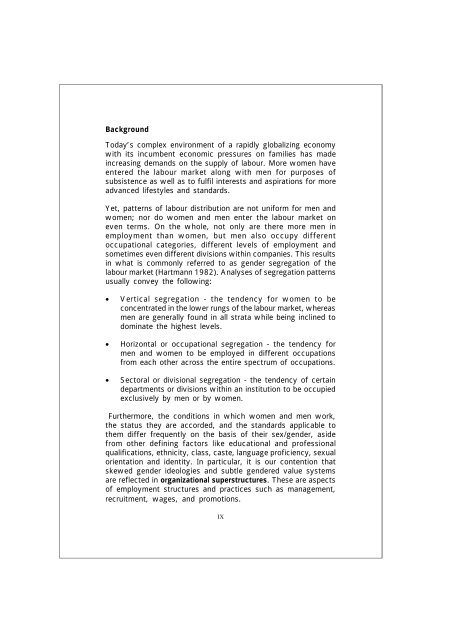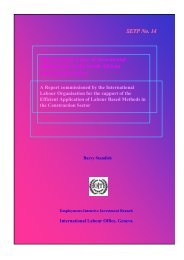Beyond Glass Ceilings and Brick Walls - International Labour ...
Beyond Glass Ceilings and Brick Walls - International Labour ...
Beyond Glass Ceilings and Brick Walls - International Labour ...
You also want an ePaper? Increase the reach of your titles
YUMPU automatically turns print PDFs into web optimized ePapers that Google loves.
Background<br />
Today’s complex environment of a rapidly globalizing economy<br />
with its incumbent economic pressures on families has made<br />
increasing dem<strong>and</strong>s on the supply of labour. More women have<br />
entered the labour market along with men for purposes of<br />
subsistence as well as to fulfil interests <strong>and</strong> aspirations for more<br />
advanced lifestyles <strong>and</strong> st<strong>and</strong>ards.<br />
Yet, patterns of labour distribution are not uniform for men <strong>and</strong><br />
women; nor do women <strong>and</strong> men enter the labour market on<br />
even terms. On the whole, not only are there more men in<br />
employment than women, but men also occupy different<br />
occupational categories, different levels of employment <strong>and</strong><br />
sometimes even different divisions within companies. This results<br />
in what is commonly referred to as gender segregation of the<br />
labour market (Hartmann 1982). Analyses of segregation patterns<br />
usually convey the following:<br />
• Vertical segregation - the tendency for women to be<br />
concentrated in the lower rungs of the labour market, whereas<br />
men are generally found in all strata while being inclined to<br />
dominate the highest levels.<br />
• Horizontal or occupational segregation - the tendency for<br />
men <strong>and</strong> women to be employed in different occupations<br />
from each other across the entire spectrum of occupations.<br />
• Sectoral or divisional segregation - the tendency of certain<br />
departments or divisions within an institution to be occupied<br />
exclusively by men or by women.<br />
Furthermore, the conditions in which women <strong>and</strong> men work,<br />
the status they are accorded, <strong>and</strong> the st<strong>and</strong>ards applicable to<br />
them differ frequently on the basis of their sex/gender, aside<br />
from other defining factors like educational <strong>and</strong> professional<br />
qualifications, ethnicity, class, caste, language proficiency, sexual<br />
orientation <strong>and</strong> identity. In particular, it is our contention that<br />
skewed gender ideologies <strong>and</strong> subtle gendered value systems<br />
are reflected in organizational superstructures. These are aspects<br />
of employment structures <strong>and</strong> practices such as management,<br />
recruitment, wages, <strong>and</strong> promotions.<br />
IX
















